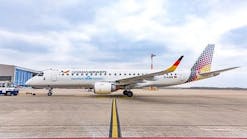All About Aircraft Oil
For Piston Engines
By Stephen M. Sunseri, ExxonMobil
March 2000
A great deal is published in aviation magazines about "best maintenance
practices." And there is no doubt that preventive maintenance is the key to keeping an aircraft ready while also reducing operating, maintenance and replacement costs for your customer.
One of the areas involving preventive maintenance that is a "given" is oil changes. Yet, as simple as this seems, there are often misunderstandings about what types of oils should be used, how often the engine should be serviced and other important elements related to engine oil. Following is a review of engine oil basics, as well as some important points to consider related to engine oils.
Viscosity
Selecting the right viscosity or "thickness" of oil for a particular engine is very important. We often hear people say "The heavier the engine oil, the better it will protect the engine." Indeed, viscosity is the single most important physical property of an engine oil because one of its primary functions is to separate moving metal parts within the engine.
However, there are trade-offs when choosing oil viscosity. Selecting a lubricant that's too thin will result in insufficient lubricant film, which can lead to increased wear of engine parts and potential metal-to-metal contact in engine parts such as journal bearings, which require hydrodynamic lubrication (separation by lubricant film).
Conversely, selecting a lubricant that's too thick will result in increased fluid friction or "drag," increased power requirements and will adversely effect fuel economy. Fluid friction will also result in mechanical overheating of engine parts and increased oil temperatures, which can accelerate oxidation and reduce a lubricant's life.
Engine OEMs recommend oil viscosity based on a particular engine's ambient operating temperature. Make sure you're using the correct oil viscosity for your customer's engine and operating conditions.
Oil Changes
Oils are designed to get dirty. That's how they keep an engine clean.
This only works if you change the oil when you're supposed to. If an engine has full-flow filtration, you should change the oil every 50 hours or every four months, whichever comes first. Without full-flow filtration, you should change the oil every 25 hours.
Since water and contaminants settle to the bottom of cold oil, you should change the oil when it's hot. When the engine is fully warmed before it is drained, a higher percentage of contaminants is removed with the oil. If you drain it when it's cold, some contaminants will remain in the oil pan and will compromise the fresh oil.
Oil Filters
Always change the oil filter when you change the oil. Otherwise, you could leave behind a quart or so of dirty oil that is mixed with the fresh oil. Additionally, filter life has been reduced by the first drain interval and may plug or fail during the next drain interval, leaving the engine unprotected.
Oil Temperature
Maintain oil temperature in the 180 to 185 F range during flight.
This range will allow moisture that has accumulated in the oil on the ramp to boil away during flight. When the aircraft sits on the ramp or in the hangar, the engine heats up during the day and cools down at night. This cooling process condenses water vapor in the engine, forming moisture, which drains into the oil. This can lead to rust on engine components.
Oil temperatures that are "in the green" are not necessarily hot enough to boil moisture away, so check the aircraft's engine temperature gauge for accuracy. Some gauges are marked with actual numbers. Some are not. If the gauge is marked, it should read approximately 212 F when the probe is placed in boiling water. If your gauge is not marked, a good practice is to mark your oil temperature gauge with a reference mark at 180 F.
In turbo-charged engines, high temperatures are often a concern. Peak temperatures can often be 70 F higher than oil sump temperatures (gauge temperatures). So if engine oil temperature is significantly above 180 F, check baffles to make sure there is good airflow to cool the cylinders. Tell the pilot to keep an eye on CHT, EGT, and lean the engine appropriately.
Oil Consumption
Some oil consumption is good. It indicates that the oil is providing a seal at the compression ring. Low oil consumption may indicate that sealing is inadequate, leading to blow-by, power loss, and increased cylinder bore wear.
So what's the right amount? Well, if engine oil consumption exceeds the oil consumption test limits as defined by the OEM (this is the number that helps determine if the rings have seated during run-in), then it's too high and there may be a problem with an unseated or broken ring.
The maximum limit for all Textron Lycoming engines can be calculated using the formula: .006 X BHP X 4 ¸ 7.4 = Quarts per hour
Again, this is the maximum rate of oil consumption allowable during run-in, and averages about one quart per hour. Following break-in, oil consumption should stabilize at some lower rate.
The lower limit is more difficult to establish because there are many variables affecting oil consumption. In the early 1980's, the University of Illinois followed 12 engines through TBO and established average rates of .081 quarts per hour and .095 quarts per hour using multi-grade and single-grade oils, respectively.
Unless there is a problem, engine oil consumption should stabilize and remain somewhere in the range of between 0.08 quarts per hour on the low end, and the oil consumption test limit should be as defined by the OEM on the high end.
Oil Analysis
If changing oil on a timely basis is the most cost-effective insurance for an engine, then oil analysis is certainly the most cost-effective rider you can add to this policy.
As an aircraft engine oil does its job, its composition changes. It accumulates contaminants, such as combustion byproducts, dirt, corrosion particles, and metallic wear particles, which can impair lubrication and accelerate wear. Analyzing the content of this used oil can help you discover engine problems before they become failures. The best part is that oil analysis costs only pennies per flight hour.
There are several things you can do to enhance the accuracy of this analysis. First, take oil samples properly.
Filling the sample container mid-way through your drain will ensure you get a representative sample and NOT all the dirt on the bottom of the pan. And, as stated previously, always drain engine oil when it is hot. Additionally, change the oil and take samples at consistent intervals.
Finally, don't rely on the results of a single sample. Unless something is drastically wrong, trends take time to develop. Trends established over five to ten drains are much more representative of what may be going on in a given engine than any single sample.
Additives
Supplementary additives - even those sold under popular brand names
- are expenses your customer can live without. If you've purchased top quality engine oil (SAE J1899), it's unnecessary for other products to be added to the crankcase.
The manufacturer of the engine oil has done all the work necessary to ensure that the oil will perform all the necessary functions the engine requires it to perform. The notable exception, of course, is the Lycoming additive LW-16702, an anti-scuffing/anti-wear additive required for some Lycoming engines (O-320-H, O-360-E, LO-360-E, TO-360-E, LTO-360-E, TIO and TIGO-541 engines).




